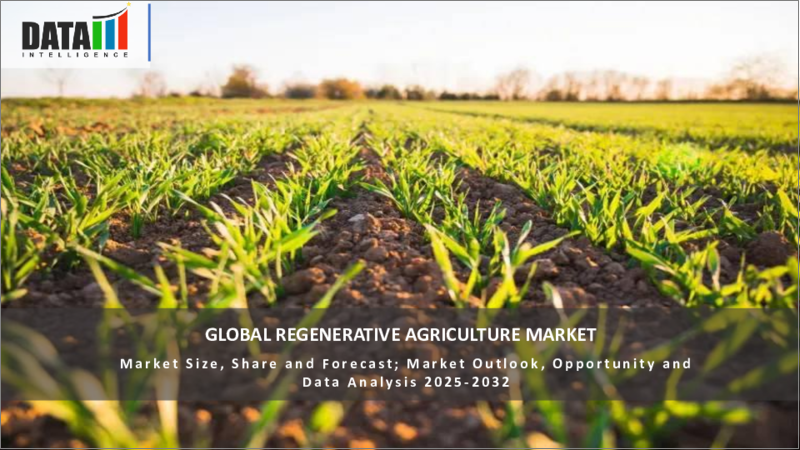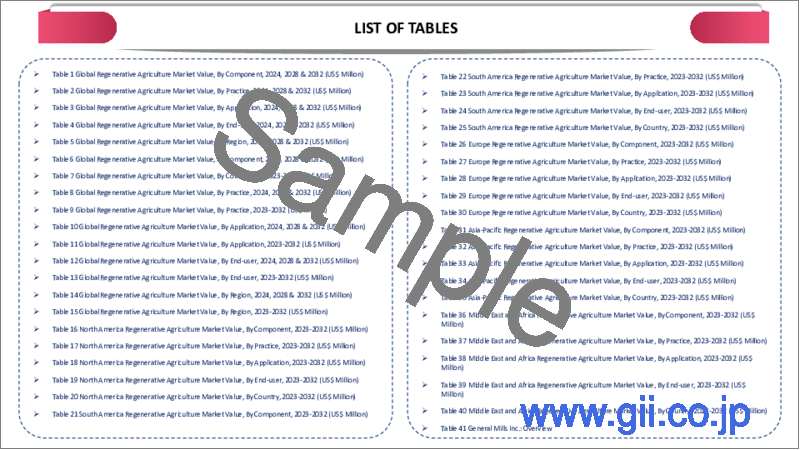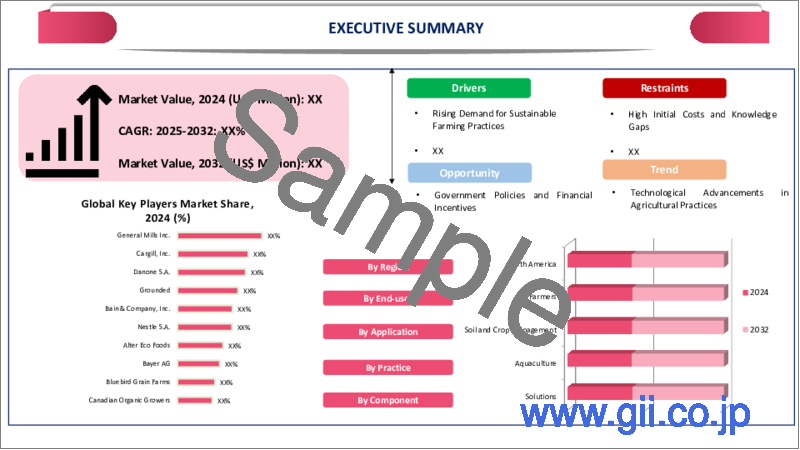|
|
市場調査レポート
商品コード
1304473
リジェネラティブ農業(環境再生型農業)の世界市場-2023年~2030年Global Regenerative Agriculture Market - 2023-2030 |
||||||
カスタマイズ可能
適宜更新あり
|
|||||||
| リジェネラティブ農業(環境再生型農業)の世界市場-2023年~2030年 |
|
出版日: 2023年07月07日
発行: DataM Intelligence
ページ情報: 英文 102 Pages
納期: 即日から翌営業日
|
- 全表示
- 概要
- 目次
市場概要
リジェネラティブ農業(環境再生型農業)の世界市場は、2022年に81億米ドルを記録し、2030年には218億米ドルに達すると予測されています。予測期間2023-2030年のCAGRは13.2%です。
リジェネラティブ農家は、土壌の健全性を高め、害虫や病気のサイクルを断ち切り、栄養循環を最適化する戦略として、多様な輪作を実施するようになってきています。カバークロップはリジェネラティブ農業において重要な役割を果たしており、その統合はこの農業アプローチにおける重要な動向です。
不耕起栽培は、耕起作業を最小限にするか完全になくすことで、土壌構造を維持し、土壌浸食を減らすのに役立ちます。保全農業はリジェネラティブ農業と密接に関連しており、いくつかの原則と実践方法を共有しています。リジェネラティブ放牧は、リジェネラティブ農業の枠組みの中で重要な実践方法です。リジェネラティブ農業の実践は、農場における水の保全を改善することを目的としています。
市場力学
増大するリジェネラティブ農業のメリット
リジェネラティブ農業は、生態系の持続可能性、土壌の健全性、生物多様性の保全、気候の回復力、農場の収益性に貢献するさまざまなメリットを提供します。リジェネラティブ農業は、健全な土壌の構築と維持に重点を置いています。被覆作物、輪作、最小限の耕起、有機質改良資材の使用などの慣行を実施することで、リジェネラティブ農家は土壌の有機物含有量を高め、土壌構造を改善し、保水力を高め、栄養循環を促進します。健全な土壌は、植物の生育を助け、浸食を減らし、干ばつやその他の環境ストレス要因に対する農業システムの回復力を高めます。
リジェネラティブ農業の技術的実践に関する農民の認識不足
農家は、リジェネラティブ農業の実践に関する情報を提供する、包括的な教育リソースにアクセスできない場合があります。これは、特にリジェネラティブ技術に焦点を当てた研修プログラム、ワークショップ、または普及サービスが不足しているためです。農業教育システムやカリキュラムもリジェネラティブ農業を十分にカバーしていない場合があり、農家は利用可能な技術的実践方法を知らないままになっています。
従来の農法や伝統的な農法を何世代にもわたって実践してきた農家は、変化に抵抗があったり、リジェネラティブ農法の利点に気づかなかったりする場合があります。彼らは慣行的な投入資材や農法に慣れ親しんでいるため、土壌の健全性、生物多様性の保全、長期的な持続可能性という点で、再生技術の潜在的な利点に気づいていない可能性があります。
COVID-19影響分析
COVID-19分析には、COVID前シナリオ、COVIDシナリオ、COVID後シナリオに加え、価格力学(COVID前シナリオと比較したパンデミック中およびパンデミック後の価格変動を含む)、需給スペクトラム(取引制限、封鎖、およびその後の問題による需給の変化)、政府の取り組み(政府機関による市場、セクター、産業を復興させる取り組み)、メーカーの戦略的取り組み(COVID問題を緩和するためにメーカーが行ったことをここで取り上げる)が含まれます。
AIの影響
AIは、作物の選択、作付けスケジュール、圃場管理方法の最適化において農家を支援することができます。過去のデータ、天候パターン、市場の需要、土壌の状態を分析することで、AIアルゴリズムは、リジェネラティブ農業の原則に沿った最適な作物と作付け戦略に関する推奨を提供し、生物多様性と長期的な持続可能性を促進することができます。
AIアルゴリズムは、天候パターン、病害虫の発生状況、過去のデータなど、さまざまなソースからのデータを分析し、作物の病害虫を予測・検出することができます。この早期発見により、農家は総合的病害虫管理戦略の実施、化学農薬への依存度の低減、作物の損失の最小化など、タイムリーな行動をとることができます。
ロシア・ウクライナ紛争の影響
紛争に関連した農民や農村住民の移転は、リジェネラティブ農業慣行の継続性を乱す可能性があります。避難した農民はリジェネラティブ農業システムを維持するのに苦労し、持続可能な農業技術を実施するための知識や経験の喪失につながる可能性があります。
紛争は、有機投入物、種子、肥料、設備など、リジェネラティブ農業に必要な資源のサプライチェーンや利用可能性を混乱させる可能性があります。農民はこれらの資源へのアクセスが困難になり、再生農法を効果的に実施する妨げになる可能性があります。
目次
第1章 調査手法と調査範囲
第2章 定義と概要
第3章 エグゼクティブサマリー
第4章 市場力学
- 影響要因
- 促進要因
- 抑制要因
- 機会
- 影響分析
第5章 産業分析
- ポーターのファイブフォース分析
- サプライチェーン分析
- 価格分析
- 規制分析
第6章 COVID-19分析
第7章 実践別
- ホリスティック計画放牧
- アグロフォレストリー
- 牧草地での作付け
- アグロエコロジー
- 水耕栽培
- シルボパスチャー
- その他
第8章 用途別
- 炭素隔離
- 栄養循環
- 生物多様性
第9章 地域別
- 北米
- 米国
- カナダ
- メキシコ
- 欧州
- ドイツ
- 英国
- フランス
- イタリア
- スペイン
- その他欧州
- 南米
- ブラジル
- アルゼンチン
- その他南米
- アジア太平洋
- 中国
- インド
- 日本
- オーストラリア
- その他アジア太平洋地域
- 中東・アフリカ
第10章 競合情勢
- 競合シナリオ
- 市況/シェア分析
- M&A分析
第11章 企業プロファイル
- General Mills Inc.
- 会社概要
- 製品ポートフォリオと説明
- 財務概要
- 主な発展
- Cargill, Inc.
- Danone S.A.
- Grounded
- Regen AG
- Nestle S.A.
- Alter Eco Americas Inc.
- New Leaf Tree Syrups
- Bluebird Grain Farms
- Regeneration Canada
第12章 付録
Market Overview
The Global Regenerative Agriculture Market US$ 8.1 billion in 2022 and is projected to witness lucrative growth by reaching up to US$ 21.8 billion by 2030. The market is growing at a CAGR of 13.2% during the forecast period 2023-2030.
Regenerative farmers are increasingly implementing diverse crop rotations as a strategy to enhance soil health, break pest and disease cycles, and optimize nutrient cycling. Cover crops play a crucial role in regenerative agriculture, and their integration is a significant trend within this farming approach.
No-till farming involves minimizing or completely eliminating tillage operations, which helps preserve soil structure and reduce soil erosion. Conservation agriculture is closely aligned with regenerative agriculture and shares several principles and practices. Regenerative grazing is a key practice within the framework of regenerative agriculture. Regenerative agriculture practices aim to improve water conservation on farms.
Market Dynamics
The Increasing Benefits of Regenerative Agriculture
Regenerative agriculture offers a range of benefits that contribute to ecological sustainability, soil health, biodiversity conservation, climate resilience, and farm profitability. Regenerative agriculture focuses on building and maintaining healthy soils. By implementing practices such as cover cropping, crop rotation, minimal tillage, and the use of organic amendments, regenerative farmers enhance soil organic matter content, improve soil structure, increase water-holding capacity, and enhance nutrient cycling. Healthy soils support better plant growth, reduce erosion, and increase the resilience of agricultural systems to drought and other environmental stressors.
Lack of Awareness Among Farmers about Technical Practices of Regenerative Agriculture
Farmers may not have access to comprehensive educational resources that provide information about regenerative agriculture practices. This can be due to a lack of training programs, workshops, or extension services that specifically focus on regenerative techniques. Agricultural education systems and curriculum may also not adequately cover regenerative agriculture, leaving farmers unaware of the available technical practices.
Farmers who have been practicing conventional or traditional farming methods for generations may be resistant to change or unaware of the benefits of regenerative practices. They may be more familiar with conventional inputs and practices and may not be aware of the potential benefits of regenerative techniques in terms of soil health, biodiversity conservation, and long-term sustainability.
COVID-19 Impact Analysis
The COVID-19 Analysis includes Pre-COVID Scenario, COVID Scenario, and Post-COVID Scenario along with Pricing Dynamics (Including pricing change during and post-pandemic comparing it to pre-COVID scenarios), Demand-Supply Spectrum (Shift in demand and supply owing to trading restrictions, lockdown, and subsequent issues), Government Initiatives (Initiatives to revive market, sector or Industry by Government Bodies) and Manufacturers Strategic Initiatives (What manufacturers did to mitigate the COVID issues will be covered here).
AI Impact
AI can assist farmers in optimizing crop selection, planting schedules, and field management practices. By analyzing historical data, weather patterns, market demand, and soil conditions, AI algorithms can provide recommendations on the most suitable crops and planting strategies that align with regenerative agriculture principles, promoting biodiversity and long-term sustainability.
AI algorithms can analyze data from various sources, including weather patterns, pest outbreaks, and historical data, to predict and detect pests and diseases in crops. This early detection allows farmers to take timely action, such as implementing integrated pest management strategies, reducing the reliance on chemical pesticides, and minimizing crop losses.
Russia-Ukraine War Impact
Conflict-related displacement of farmers and rural populations can disrupt the continuity of regenerative agricultural practices. Displaced farmers may struggle to maintain their regenerative farming systems, leading to a loss of knowledge and experience in implementing sustainable agricultural techniques.
The conflict can disrupt the supply chains and availability of resources needed for regenerative agriculture, such as organic inputs, seeds, fertilizers, and equipment. Farmers may face difficulties in accessing these resources, hindering their ability to implement regenerative practices effectively.
Segment Analysis
The global regenerative agriculture market is segmented based on practice, and application, and region.
Increase in the Adoption of Holistic Planned Grazing (HPG) in Regenerative Agriculture
Holistic Planned Grazing (HPG) is a practice within regenerative agriculture that focuses on the management of livestock in a way that mimics natural grazing patterns, promotes soil health, improves biodiversity, and restores ecosystem functions.
HPG involves careful planning of livestock grazing activities. It considers factors such as forage availability, plant growth stages, soil conditions, and landscape features to determine the timing, duration, and intensity of grazing in specific areas. This planning ensures that livestock has access to high-quality forage while avoiding overgrazing and promoting plant and soil health.
Geographical Analysis
Increase in the Government Initiatives for Regenerative Agriculture in North America
Rising government initiatives to promote innovative agriculture techniques, along with increased awareness about soil improvement, are expected to grow in the North American region in the coming years. Some of the major key players in the market increase their investments in regenerative agriculture. For instance, on March 21, 2023, PepsiCo announced plans to invest $216 million over 3 million acres of US farms in regenerative agriculture projects. The strategy calls for multi-year collaborations with the Illinois Corn Growers Association (ICGA), Practical Farmers of Iowa (PFI), and Soil and Water Outcomes Fund (SWOF).
Competitive Landscape
The major global players include: General Mills Inc., Cargill, Inc., Danone S.A., Grounded, Regen AG, Nestle S.A., Alter Eco Americas Inc., New Leaf Tree Syrups, Bluebird Grain Farms and Regeneration Canada.
Why Purchase the Report?
- To visualize the global regenerative agriculture market segmentation based on practice, application and region, as well as understand key commercial assets and players.
- Identify commercial opportunities by analyzing trends and co-development.
- Excel data sheet with numerous data points of regenerative agriculture market-level with all segments.
- PDF report consists of a comprehensive analysis after exhaustive qualitative interviews and an in-depth study.
- Product mapping available as Excel consisting of key products of all the major players.
The Global Regenerative Agriculture Market Report Would Provide Approximately 53 Tables, 46 Figures, and 102 pages.
Target Audience 2023
- Manufacturers/ Buyers
- Industry Investors/Investment Bankers
- Research Professionals
- Emerging Companies
Table of Contents
1. Methodology and Scope
- 1.1. Research Methodology
- 1.2. Research Objective and Scope of the Report
2. Definition and Overview
3. Executive Summary
- 3.1. Snippet by Practice
- 3.2. Snippet by Application
- 3.3. Snippet by Region
4. Dynamics
- 4.1. Impacting Factors
- 4.1.1. Drivers
- 4.1.2. Restraints
- 4.1.3. Opportunity
- 4.1.4. Impact Analysis
5. Industry Analysis
- 5.1. Porter's Five Force Analysis
- 5.2. Supply Chain Analysis
- 5.3. Pricing Analysis
- 5.4. Regulatory Analysis
6. COVID-19 Analysis
- 6.1. Analysis of COVID-19
- 6.1.1. Scenario Before Covid-19
- 6.1.2. Scenario During Covid-19
- 6.1.3. Scenario Post COVID-19
- 6.2. Pricing Dynamics Amid COVID-19
- 6.3. Demand-Supply Spectrum
- 6.4. Government Initiatives Related to the Market During Pandemic
- 6.5. Manufacturers Strategic Initiatives
- 6.6. Conclusion
7. By Practice
- 7.1. Introduction
- 7.1.1. Market Size Analysis and Y-o-Y Growth Analysis (%), By Practice
- 7.1.2. Market Attractiveness Index, By Practice
- 7.2. Holistic Planned Grazing*
- 7.2.1. Introduction
- 7.2.2. Market Size Analysis and Y-o-Y Growth Analysis (%)
- 7.3. Agroforestry
- 7.4. Pasture Cropping
- 7.5. Agroecology
- 7.6. Aquaculture
- 7.7. Silvopasture
- 7.8. Others
8. By Application
- 8.1. Introduction
- 8.1.1. Market Size Analysis and Y-o-Y Growth Analysis (%), By Application Market Attractiveness Index, By Application
- 8.2. Carbon Sequestration *
- 8.2.1. Introduction
- 8.2.2. Market Size Analysis and Y-o-Y Growth Analysis (%)
- 8.3. Nutrient Cycling
- 8.4. Biodiversity
9. By Region
- 9.1. Introduction
- 9.1.1. Market Size Analysis and Y-o-Y Growth Analysis (%), By Region
- 9.1.2. Market Attractiveness Index, By Region
- 9.2. North America
- 9.2.1. Introduction
- 9.2.2. Key Region-Specific Dynamics
- 9.2.3. Market Size Analysis and Y-o-Y Growth Analysis (%), By Practice
- 9.2.4. Market Size Analysis and Y-o-Y Growth Analysis (%), By Application
- 9.2.5. Market Size Analysis and Y-o-Y Growth Analysis (%), By Country
- 9.2.5.1. The U.S.
- 9.2.5.2. Canada
- 9.2.5.3. Mexico
- 9.3. Europe
- 9.3.1. Introduction
- 9.3.2. Key Region-Specific Dynamics
- 9.3.3. Market Size Analysis and Y-o-Y Growth Analysis (%), By Practice
- 9.3.4. Market Size Analysis and Y-o-Y Growth Analysis (%), By Application
- 9.3.5. Market Size Analysis and Y-o-Y Growth Analysis (%), By Country
- 9.3.5.1. Germany
- 9.3.5.2. The U.K.
- 9.3.5.3. France
- 9.3.5.4. Italy
- 9.3.5.5. Spain
- 9.3.5.6. Rest of Europe
- 9.4. South America
- 9.4.1. Introduction
- 9.4.2. Key Region-Specific Dynamics
- 9.4.3. Market Size Analysis and Y-o-Y Growth Analysis (%), By Practice
- 9.4.4. Market Size Analysis and Y-o-Y Growth Analysis (%), By Application
- 9.4.5. Market Size Analysis and Y-o-Y Growth Analysis (%), By Country
- 9.4.5.1. Brazil
- 9.4.5.2. Argentina
- 9.4.5.3. Rest of South America
- 9.5. Asia-Pacific
- 9.5.1. Introduction
- 9.5.2. Key Region-Specific Dynamics
- 9.5.3. Market Size Analysis and Y-o-Y Growth Analysis (%), By Practice
- 9.5.4. Market Size Analysis and Y-o-Y Growth Analysis (%), By Application
- 9.5.5. Market Size Analysis and Y-o-Y Growth Analysis (%), By Country
- 9.5.5.1. China
- 9.5.5.2. India
- 9.5.5.3. Japan
- 9.5.5.4. Australia
- 9.5.5.5. Rest of Asia-Pacific
- 9.6. Middle East and Africa
- 9.6.1. Introduction
- 9.6.2. Key Region-Specific Dynamics
- 9.6.3. Market Size Analysis and Y-o-Y Growth Analysis (%), By Practice
- 9.6.4. Market Size Analysis and Y-o-Y Growth Analysis (%), By Application
10. Competitive Landscape
- 10.1. Competitive Scenario
- 10.2. Market Positioning/Share Analysis
- 10.3. Mergers and Acquisitions Analysis
11. Company Profiles
- 11.1. General Mills Inc.*
- 11.1.1. Company Overview
- 11.1.2. Product Portfolio and Description
- 11.1.3. Financial Overview
- 11.1.4. Key Developments
- 11.2. Cargill, Inc.
- 11.3. Danone S.A.
- 11.4. Grounded
- 11.5. Regen AG
- 11.6. Nestle S.A.
- 11.7. Alter Eco Americas Inc.
- 11.8. New Leaf Tree Syrups
- 11.9. Bluebird Grain Farms
- 11.10. Regeneration Canada
LIST NOT EXHAUSTIVE
12. Appendix
- 12.1. About Us and Services
- 12.2. Contact Us






